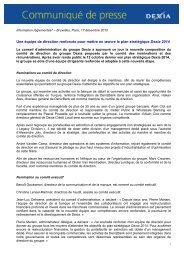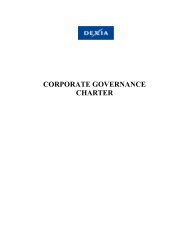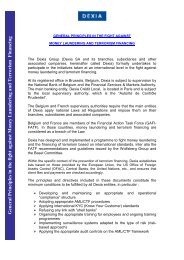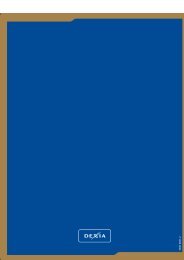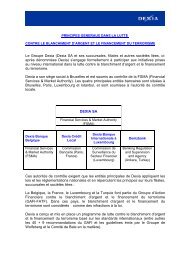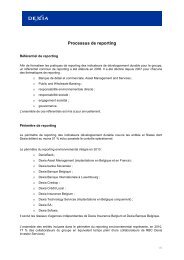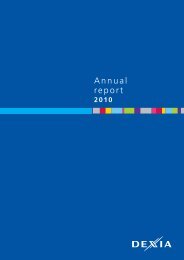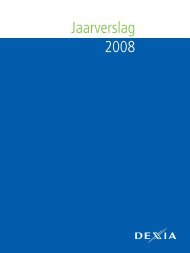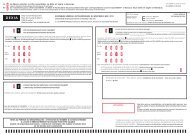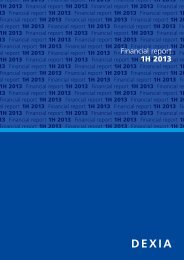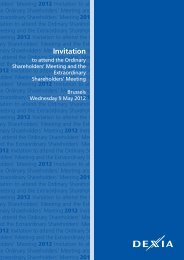Annual report 2009 - Dexia.com
Annual report 2009 - Dexia.com
Annual report 2009 - Dexia.com
- No tags were found...
Create successful ePaper yourself
Turn your PDF publications into a flip-book with our unique Google optimized e-Paper software.
Notes to the consolidated fi nancial statementsManagement <strong>report</strong>Consolidatedfinancial statements<strong>Annual</strong> financial statementsAdditional information<strong>com</strong>ponent; accounting policies for financial instruments areapplied for the deposit <strong>com</strong>ponent.The unit-linked products that can be converted into a guaranteedinvestment product (branch 21) with profit sharingfall under IFRS 4 (investment with DPF) and will not beunbundled.Embedded derivativesIAS 39 applies to derivatives embedded in an insurancecontract unless the embedded derivative is itself an insurancecontract. The requirements for insurance contractswith DPF also prevail for financial instruments with DPFelements.As an exception to the requirement in IAS 39, <strong>Dexia</strong> doesn’tneed to separate, and measure at fair value, a policyholder’soption to surrender an insurance contract for a fixed amount(or for an amount based on a fixed amount and an interestrate), even if the exercise price differs from the carrying amountof the host insurance liability. However, the requirement inIAS 39 does apply to a put option or cash surrender optionembedded in an insurance contract if the surrender value variesin response to the change in a financial variable (such as anequity or <strong>com</strong>modity price or index), or a non-financial variablethat is not specific to a party to the contract.DPF in financial instrumentsIf the issuer classifies part or that entire feature as a separate<strong>com</strong>ponent of equity, the liability recognised for the wholecontract shall not be less than the amount that would resultfrom applying IAS 39 to the guaranteed element.<strong>Dexia</strong> reviews at each <strong>report</strong>ing date whether this minimumrequirement is met and in case of an insufficiency, the correspondingliabilities are adjusted accordingly.Liability Adequacy TestsAn insurer applies a liability adequacy test (LAT) for its insuranceproducts and investment contracts with DPF. <strong>Dexia</strong>assesses at each <strong>report</strong>ing date whether its recognised insuranceliabilities are adequate, using current estimates of futurecash flows under its insurance contracts.If that assessment (based on the entire life and nonlife insuranceportfolios separately) shows that the carrying amount ofits insurance liabilities (less related deferred acquisition costsand related intangible assets) is inadequate in the light ofthe estimated future cash flows, the entire deficiency shall berecognised in profit or loss.For life insurance, LAT uses the following parameters, whichare based on the Royal Decree of 14 November 2003 withrespect to the life business:• premiums: collected inventory premiums plus contractualprovided inventory premiums;• interest rate for actualisation cash flows: yields of the assetsbacking insurance liabilities;• mortality table: experience table of the country (Assuraliafor Belgium);• costs: calculation based on the last updated tariff costs andthe booked costs;• tariff costs take into account the inventory surcharges,<strong>com</strong>mercial surcharges and fixed sums;• real assigned costs take into account managementexpenses, claims handling expenses and <strong>com</strong>missions. Thesecosts are stipulated by product group and are indexed. Consideringlapses, death and expiration period the annual deltais stipulated between the costs in the tariff and real assignedcosts. Deltas are then actualised to the LAT-rate.For nonlife insurance, the LAT that examines if the premiumand claim provisions are sufficient to settle definitely theopened claim files and the claims that will occur within thecontractual duration of the contracts to open and to settledefinitively.A LAT is carried out for all products. The test is subdividedinto two parts. During the first part <strong>Dexia</strong> examines if thebuilt up reserves for claim files already opened are sufficient,and in a second part <strong>Dexia</strong> makes an estimation of theexpected loss burden for insurance portfolios and examines ifthe unearned premium reserves are sufficient.Regarding reserves for the files already opened, <strong>Dexia</strong> performsrunoff calculations, using estimates for the claims handlingexpenses.For the assessment of loss burden for the insurance portfolio,<strong>Dexia</strong> conducts a reasoning that is based on percentages(average loss burden of the last 5 years and administrativeexpenses of the last year).FSA activitiesGeneral<strong>Dexia</strong> is active in credit enhancement of public finance andasset-backed obligations through Financial Security AssuranceInc. (FSA) located in the U.S. Some insurance products soldby insurance <strong>com</strong>panies are considered as insurance contractsunder IFRS 4. <strong>Dexia</strong> is applying IFRS 4 as from 1 January2005, in order to be consistent with its date of first-timeadoption of IAS 32 and 39.Financial guaranty insurance generally provides an unconditionaland irrevocable guaranty that protects the holder ofa financial obligation against non-payment of principal andinterest when due. Upon a payment default on an insuredobligation, <strong>Dexia</strong> is generally required to pay the principal,interest or other amounts due in accordance with the obligation’soriginal payment schedule or, at its option, to paysuch amounts on an accelerated basis. The contract may beconsidered a derivative or an insurance contract dependingon certain legal characteristics.Gross and ceded premiums received in upfront payouts areearned in proportion to the amount of risk outstanding overthe expected period of coverage. Deferred premium revenueand prepaid reinsurance premiums represent the portion ofpremium that is applicable to coverage of risk to be providedin the future on policies in force.<strong>Dexia</strong> establishes provisions for losses liabilities based onits estimate of specific and non-specific losses. <strong>Dexia</strong> alsoestablishes provisions for loss adjustment expenses, consistingof the estimated cost of settling claims, including legaland other fees and expenses associated with administeringthe claims process. <strong>Dexia</strong> calculates a loss and loss adjustmentexpense liability based upon identified risks inherent inits insured portfolio. If an individual policy risk has a probableloss as at the balance sheet date, a specific reserve isestablished. For the remaining policy risks in the portfolio, anon-specific reserve is established to account for the inherentcredit losses that can be statistically estimated.112<strong>Dexia</strong> <strong>Annual</strong> <strong>report</strong> <strong>2009</strong>



